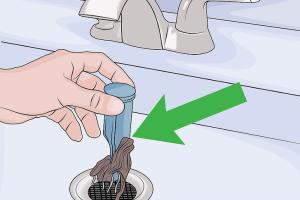Ultimate Guide: How to Clean a Bathroom Sink Drain Effectively

-
Quick Links:
- Introduction
- Understanding Bathroom Sink Drains
- Why Regular Cleaning is Essential
- Tools and Materials Needed
- Step-by-Step Cleaning Guide
- Common Problems and Solutions
- Expert Insights and Tips
- Environmental Impact and Eco-Friendly Alternatives
- Case Studies: Success Stories
- FAQs
Introduction
Cleaning your bathroom sink drain might seem like a daunting task, but with the right knowledge and tools, it can be a straightforward and rewarding process. This guide will take you through everything you need to know about keeping your sink drain clean and functioning optimally.
Understanding Bathroom Sink Drains
Bathroom sink drains are designed to carry wastewater away from your sink, but over time, they can become clogged with hair, soap scum, and other debris. Understanding how your sink drain works will help you maintain it better.
The Anatomy of a Sink Drain
A typical bathroom sink drain consists of several components:
- Strainer: This sits at the top of the drain and catches hair and large debris.
- P-Trap: This curved section of pipe keeps a small amount of water to block sewer gases from entering your home.
- Drain Pipe: This connects the P-trap to the home's plumbing system.
Why Regular Cleaning is Essential
Regularly cleaning your sink drain helps prevent clogs, bad odors, and potential plumbing issues. According to a study by the National Sanitation Foundation, sinks harbor more germs than toilet seats, making regular cleaning crucial for maintaining a healthy home environment.
Tools and Materials Needed
Before you begin, gather the following tools and materials:
- Plunger
- Drain snake
- White vinegar
- Baking soda
- Hot water
- Rubber gloves
- Bucket
- Old toothbrush or small scrub brush
Step-by-Step Cleaning Guide
Step 1: Prepare Your Workspace
Make sure you have adequate lighting and access to all necessary tools. Wear rubber gloves to protect your hands from dirt and chemicals.
Step 2: Remove the Strainer
Using a screwdriver, carefully remove the strainer from the drain. This will give you access to the drain's interior.
Step 3: Clear Out Debris
Use your fingers or a small brush to remove visible debris. For more stubborn clogs, use a drain snake to reach deeper into the drain.
Step 4: Use Baking Soda and Vinegar
Pour about half a cup of baking soda down the drain, followed by half a cup of vinegar. Let this mixture fizz for about 15-20 minutes to help break down any remaining gunk.
Step 5: Flush with Hot Water
After the fizzing has subsided, boil a kettle of water and carefully pour it down the drain to flush away the debris and cleaning agents.
Step 6: Reassemble the Strainer
Once the drain is clear, reattach the strainer securely to prevent future clogs.
Common Problems and Solutions
Even with regular cleaning, you may encounter common problems:
- Slow Drain: This often indicates a buildup of debris. Follow the cleaning steps above to remedy this.
- Bad Odor: If your sink emits an unpleasant smell, it may be due to stagnant water in the P-trap. Clean it out thoroughly.
- Frequent Clogs: If clogs are a recurring issue, consider using a drain snake regularly or consulting a plumber for a deeper inspection.
Expert Insights and Tips
Experts recommend regular maintenance to prevent clogs. Here are some tips:
- Use a hair catcher in your sink to prevent hair from going down the drain.
- Run hot water down the drain regularly to help dissolve soap scum.
- Avoid pouring grease or oil down the sink, as it can solidify and cause clogs.
Environmental Impact and Eco-Friendly Alternatives
Using harsh chemicals can be harmful to the environment. Instead, opt for natural cleaning solutions like vinegar and baking soda. These ingredients are not only effective but also eco-friendly.
Case Studies: Success Stories
Many homeowners have found success with regular maintenance routines. A case study in a suburban neighborhood revealed that families who followed a monthly drain cleaning schedule reported fewer plumbing issues and better overall sanitation in their bathrooms.
FAQs
1. How often should I clean my bathroom sink drain?
It’s recommended to clean your sink drain at least once a month to prevent clogs and buildup.
2. What can I use if I don't have a drain snake?
You can use a wire hanger or a straightened coat hanger to reach down into the drain and remove debris.
3. Is vinegar safe for all types of drains?
Yes, vinegar is safe for most plumbing systems and is an effective natural cleaner.
4. How do I know if my drain is clogged?
Signs of a clogged drain include slow drainage, gurgling sounds, and unpleasant odors.
5. What should I avoid putting down the drain?
Avoid grease, coffee grounds, and large food particles, as these can lead to clogs.
6. Can I use chemical drain cleaners?
While effective, chemical drain cleaners can be harsh on plumbing and the environment. It’s better to use natural alternatives.
7. What if my drain is still clogged after cleaning?
If your drain remains clogged, you may need to consult a plumber for more advanced solutions.
8. Can hair clogs be prevented?
Yes, using a hair catcher can significantly reduce the amount of hair that goes down the drain.
9. Are there any eco-friendly drain cleaning options?
Yes, using a mix of baking soda and vinegar is a great eco-friendly option for cleaning drains.
10. Should I clean my P-trap?
Yes, cleaning the P-trap periodically is important to prevent odors and clogs.
Random Reads